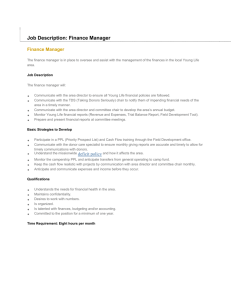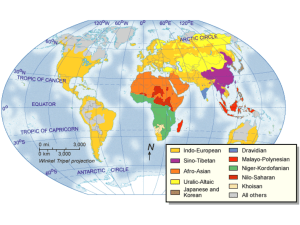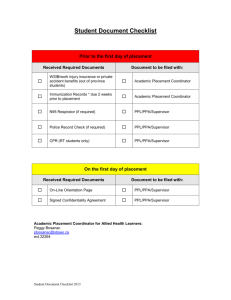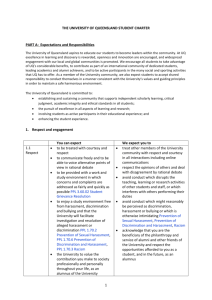PPL knowledge base
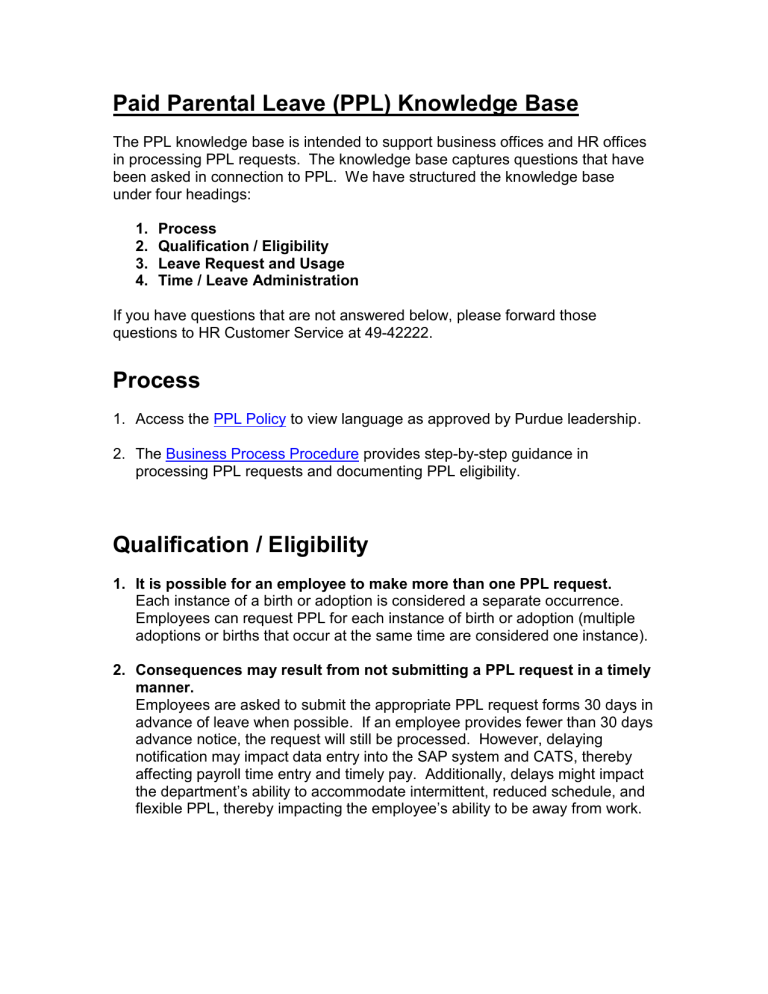
Paid Parental Leave (PPL) Knowledge Base
The PPL knowledge base is intended to support business offices and HR offices in processing PPL requests. The knowledge base captures questions that have been asked in connection to PPL. We have structured the knowledge base under four headings:
1. Process
2. Qualification / Eligibility
3. Leave Request and Usage
4. Time / Leave Administration
If you have questions that are not answered below, please forward those questions to HR Customer Service at 49-42222.
Process
1. Access the PPL Policy to view language as approved by Purdue leadership.
2. The Business Process Procedure provides step-by-step guidance in processing PPL requests and documenting PPL eligibility.
Qualification / Eligibility
1. It is possible for an employee to make more than one PPL request.
Each instance of a birth or adoption is considered a separate occurrence.
Employees can request PPL for each instance of birth or adoption (multiple adoptions or births that occur at the same time are considered one instance).
2. Consequences may result from not submitting a PPL request in a timely manner.
Employees are asked to submit the appropriate PPL request forms 30 days in advance of leave when possible. If an employee provides fewer than 30 days advance notice, the request will still be processed. However, delaying notification may impact data entry into the SAP system and CATS, thereby affecting payroll time entry and timely pay. Additionally, delays might impact the department’s ability to accommodate intermittent, reduced schedule, and flexible PPL, thereby impacting the employee’s ability to be away from work.
3. Qualification for PPL is dependent upon the official birth or adoption date.
Employees who do not meet the 12-month continuous employment policy criteria at the time of a birth or adoption are not eligible for PPL in connection to that birth or adoption. The summer months count toward the 12 continuous months of employment for academic year paid employees who remain in a benefits eligible employment status during the summer months.
4. PPL documents submitted by the employee to support PPL eligibility should be forwarded to HRSC in FREH.
We generally request that supporting documentation be submitted no later than 15 days after the birth or adoption. Birth and adoption paperwork used to authenticate PPL is kept in the Human Resource Service Center in FREH.
Employees can submit one of the following documents to validate the need for leave:
Legal documentation establishing adoption
Birth certificate or legal document establishing paternity
Submit questions concerning documentation to HR Customer Service at 49-
42222
5. Individual PPL quota allocation is calculated based upon CUL.
When the policy mentions 240 hours, this is based upon 100% CUL. This amount is adjusted based upon the individual ’s actual CUL assignment.
6. Same-sex domestic partnerships may qualify for PPL.
HR Customer Service will help to facilitate PPL instances involving same-sex domestic partnerships, forward questions to 49-42222.
Leave Request and Usage
1. Usage of PPL is limited to certain events.
PPL can only be requested and used in connection to a birth, recovery from birth, bonding, or adoption. If an employee requires time off for reasons other than the above, another form of leave must be used.
2. Employees must use PPL within a specific timeframe.
Employees have a maximum of 12 months from the date of birth or adoption to use the designated PPL. After 12 months, all unused leave time will be forfeited by the employee.
3. The employee has discretion on how and when to take the PPL.
PPL is one option for employees to take time off in paid status. Employees may elect to use their PPL in any combination with other leaves or in any order they might choose. However, the employee is limited to using each leave as outlined in each specific leave policy.
4. Supervisors must grant continuous PPL. This policy requires 30 days advance notice of leave when possible.
Continuous PPL is the period of time wherein the employee first starts PPL, up to the time the employee returns from the initial PPL time off. There are continuous PPL scenarios in which the employee may elect to use 100 percent of the PPL time before returning to work from the initial PPL; however, this is not always the case. Should the employee return to work from the initial PPL before exhausting all PPL, any remaining PPL time used by the employee after returning from the initial period of PPL will be considered intermittent or reduced schedule leave.
5. Supervisors and employees must work collaboratively to schedule intermittent PPL or reduced schedule PPL. Intermittent or reduced schedule leave may not be taken in increments of less than one hour.
This policy requires 30 days advance notice of leave when possible.
Departments and supervisors work in partnership with the employee to schedule and grant intermittent and reduced schedule leave. When the department and employee are not able to develop/agree upon an intermittent leave schedule, Human Resources will coordinate further discussion between the employee and supervisor. An employee may elect to grieve if the PPL is denied. It is important that supervisors attempt to balance the employee’s
PPL time with the business needs of the area.
6.
PPL usage will reduce the employee’s FMLA balance.
When employees have met the eligibility standards for FMLA and request to use PPL, the two leaves will run concurrently. PPL will be used to maintain the employee in paid status. PPL leave time directly reduces the employee's
FMLA balance, thereby reducing the amount of time the employee can be away from work for a serious health condition in a job-protected status.
7. PPL grants an employee time away from work in paid status.
PPL allows an employee to remain in paid leave status while away from his or her regularly scheduled work time. Employees may not request PPL during times when the employee is not scheduled to work.
8. Employees on PPL are afforded all benefits and opportunities afforded to their position.
During PPL, employees remain in paid status and are afforded all benefits and opportunities afforded to their position.
9. In the unfortunate scenario that a mother gives birth and loses the child, the mother will qualify for PPL for purposes of recovery from childbirth.
The PPL policy affords the mother time to recover physically from child birthing. The medical provider, in conjunction with HR, determines recovery time.
Time / Leave Administration
1. PPL is tracked in both SAP and CATS.
It is important that the PPL business process procedure is followed to ensure that the appropriate forms are completed. The completion of paperwork provides the necessary data to administer PPL in SAP and CATS.
2. Employees on PPL remain in paid status.
During PPL, an employee will remain in paid status and is eligible for all privileges granted to employees in paid status.
3. Employees on PPL are eligible for holiday pay.
If a holiday occurs while an employee is on PPL, the PPL is suspended for the day(s) and the employee receives holiday pay instead.
4. When charging PPL to an employee on grants, please be aware of the following:
Guidelines for Charging Paid Parental Leave to Sponsored Program
Accounts
Sponsored Projects
PPL is an allowable direct charge to sponsored program accounts for the entire approved leave. The paid leave should be prorated on the basis of the projects the individual is working on at the time the leave is taken.
In the case of intermittent leave, the paid leave should be prorated on the basis of the projects the individual is working on at the time each period of intermittent leave begins.
Voluntary Support Accounts Administered by SPS
PPL is an allowable direct cost for the entire length of the approved leave on voluntary support accounts administered by Sponsored
Program Services.
Voluntary support accounts are unrestricted accounts, and, therefore, can be charged for PPL on any basis under the guidelines for PPL.
5. Employees receiving short term disability (STD) are eligible to use PPL to supplement and maintain 100 percent pay.
An employee may elect to use PPL to supplement her STD pay, granting the employee 100 percent of her pay, or she may elect to use PPL after exhausting her STD, thereby extending her time away from work. Whatever
the choice, employees will not receive compensation in excess of 100% of their regular pay when supplementing STD with other forms of leave.
6. The PPL rate of compensation should be the same as vacation or sick leave.
PPL is compensated at the same rate as if an employee were using other forms of leave time, such as vacation or sick leave (e.g., if an employee would receive a shift differential while taking vacation or sick time, he or she would also receive a shift differential while on PPL).
7. Departments are responsible for paying PPL time for employees.
In cases of concurrent employment, departments pay the percentage associated with the employee ’s CUL designated to each area.

